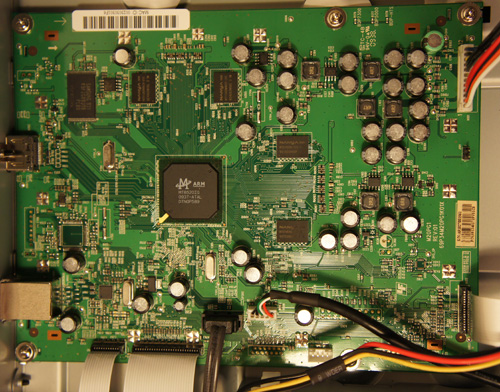The Ware for January 2011 is a BluRay optical pick-up head. There aren’t too many good photos of these on the web, although I did find a fascinating tear-down of the unit used inside a Sony PS3 from 2007. This particular unit is from a Lite-On OEM module manufactured on October 15 2009, from an HP BD-2000 BluRay player. Below is a photo of the motherboard from the BD-2000 player.
One notable features of the pickup-head is that the entire optics assembly — the piece with two lenses on it molded out of white plastic — “floats” on six whiskers of wire. Three of the whiskers are visible in the front. The entire assembly is buttressed by a set of voice coils that manipulate the assembly’s position by pushing against adjacent fixed permanent magnets. If you take a pair of tweezers and poke the assembly it jiggles freely. The mechanical design ingenuity and manufacturing tolerance that goes into making this is impressive, especially for a low-cost mass-market item.
Back when I designed nanophotonic integrated circuits at Luxtera, we had a problem with aligning single-mode fibers to grating couplers on the surface of a wafer. The single mode fiber alignment problem typically requires expensive manufacturing equipment and highly trained operators to get the laser lined up in three dimensions to within a micron of the optimal launch spot, after which the whole assembly is glued in place. This is a bummer, because if the glue shifts during setting or the operator makes a mistake, a very expensive optical assembly is lost.
Thus, I find it amusing that this low-cost assembly can do that and more, on the fly. According to this white paper, an optics assembly like this can achieve a tracking error of 8 nanometers on an assembly that’s moving around, thus allowing dynamic tracking of the laser spot onto media with a track pitch of 320 nm, much smaller than the micron or so spot size of a single mode fiber.
As for the winner this month, it’s Felix. I actually learned quite a bit reading his entry; for example, I didn’t know that the circle segments on the PCB were for ESD management. Thanks for the detailed lesson. Congrats, email me for your prize!

It’s amazing how few parts and chips they are now down to; that arm chip does almost everything. One of the first HDVD players (Toshiba HD-A1) had a pentium cpu, several fpgas, and an entire daughter board for a/v. Lot more fun and much easier to get code running on.
Im not going to say what everybody else has already said, however I do want to comment in your data of the topic. Youre truly nicely-informed. I cant think about how a variety of this I merely wasnt conscious of. Thanks for bringing additional knowledge to this matter for me. Im truly grateful and truly impressed.
Thank you so much for sharing this article. It was fascinating and at the moment you watch it, you surely gained’t forget it Very informative blog. I believe many could benefit from reading your blog subsequently I am subscribing to it and telling all my pals